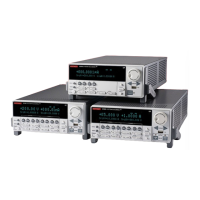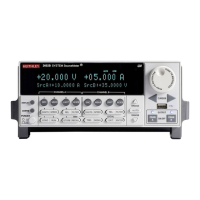12-20 Instrument Control Library Series 2600 System SourceMeters Reference Manual
2600S-901-01 Rev. A / May 2006 Return to Section 12 topics
digio functions and attributes
The functions and attributes in this group are used to control read/write and trigger
operations for the digital I/O Port.
NOTE The digital I/O lines can be used for both input and output. If a line is being
driven low, then a “0” value will be read by a command for that line. You
must write a “1” to all digital I/O lines that are to be used as inputs.
digio.readbit
Function Reads one digital I/O line.
Usage data = digio.readbit(line)
line Digital I/O line number to be read (1 to 14).
Remarks A returned value of “0” indicates that the line is low. A returned value of “1” indicates
that the line is high.
Details See “Digital I/O port” in Section 10.
Also see digio.readport, digio.writebit, digio.writeport
Example Assume line 4 is set high, and it is then read:
data = digio.readbit(4)
print(data)
Output: 1.000000e+00
digio.readport
Function Reads the digital I/O port.
Usage data = digio.readport()
Remarks The binary equivalent of the returned value indicates the input pattern on the I/O port.
The least significant bit of the binary number corresponds to line 1 and bit 14
corresponds to line 14. For example, a returned value of 170 has a binary equivalent of
00000010101010. Lines 2, 4, 6 and 8 are high (1), and the other 10 lines are low (0).
Details See “Digital I/O port” in Section 10.
Also see digio.readbit, digio.writebit, digio.writeport
Example
Assume lines 2, 4, 6 and 8 are set high, and the I/O port is then read:
data = digio.readport()
print(data)
Output: 1.700000e+02 (binary 10101010)

